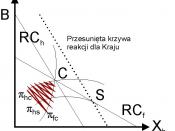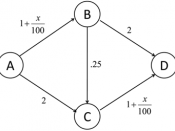Discuss examples where different models might be the most appropriate (think for example of market for raw materials or for air travel).
In this essay I am going to discuss models of oligopoly behaviour and analyse them and see whether they are realistic or not and evaluate them with certain examples where they may be most suitable.
Oligopoly is defined as a market form in which a market is dominated by a small number of sellers. There are many different models for oligopoly behaviour such as the Cournot Solution, the Sweezy Kinked Demand Curve Solution, the Stackelberg Model and the Bertrand Model.
The Cournot model focuses on the behaviour of quantities, prices and profits within a duopoly (if two firms are selling products in the same market). Within this model it is assumed that one firm will not react to all changes from the other firm's decision. Firm 1 can choose an output of p1, assuming firm 2 had a fixed level of output at p2.
The same assumption can be made the other way; for example, p2 is chosen supposing that p1 can be treated by the second firm as given. Within oligopolistic markets there are a huge number of firms so this hypothesis makes sense as firms can make their decisions without basing it on another's decision. However, on the other hand, even though it is in a duopoly, in the Cournot equilibrium other firms will still notice change of the other firms if quantities are not changing.
Another way to analyse the Cournot equilibrium mathematically is to say the industry demand curve is:
An isoprofit curve is "the locus of points in a space defined by different levels of output for both firms 1 and 2 which yield the same level of profit to firm 1."` They...



Comment
Cournot models make more sense if you think of the firms as setting capacity, and then producing up to capacity (so marginal costs are low)
0 out of 0 people found this comment useful.